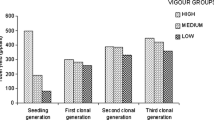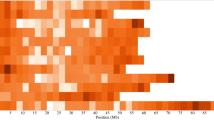Abstract
Potato production in the eastern United States occurs over a wide range of environments from Maine to Florida; many of these states do not have a breeding program. Initial selections are usually made at the breeding location for more than 2 years before undergoing evaluation elsewhere, at which point, few clones remain from the original population. The purpose of this study was to determine if parents that produce progeny with broad adaptation could be identified early in the USDA/ARS Potato Breeding Program. For 3 years (2007–2009), seed of all second field generation clones was distributed to five locations for selection. In 2008, 2009 and 2010, selections were made among 339, 321, and 381 clones, respectively. For each parent in each year, Chi-square values were calculated from the observed and expected number of progeny selected. Each year, parents that produced poorly- or broadly-adapted offspring were identified. Among the progeny selected at three or more locations, 27 to 70 % had not been selected by the breeding program. Early generation selection can be used to identify parents that produce broadly adapted progeny and may identify broadly adapted progeny before they are discarded by the breeding program. Because potatoes display such strong genotype × environment interactions, this selection approach may be particularly beneficial for selecting potato cultivars with broad adaptation.
Similar content being viewed by others
References
Bae J, Jansky SH, Rouse DI (2008) The potential for early generation selection to identify potato clones with resistance to Verticillium wilt. Euphytica 164:385–393
Blomquist AW, Lauer FI (1962) First clonal generation potato progeny performance at two Minnesota locations. Am Potato J 39:460–463
Bradshaw JE, Dale MFB, Swan GEL, Todd D, Wilson RN (1998) Early-generation selection between and within pair crosses in a potato (Solanum tuberosum subsp. Tuberosum) breeding programme. Theor Appl Genet 97:1331–1339
Bradshaw JE, Dale MFB, Mackay GR (2003) Use of mid-parent values and progeny tests to increase the efficiency of potato breeding for combined processing quality and disease and pest resistance. Theor Appl Genet 107:36–42
Brown J (1988) The effect of the weight of the seedling-derived tuber on subsequent clonal generations in potato breeding programme. Ann Appl Biol 11:69–78
Brown J, Caligari PDS, Mackay GR, Swan GEL (1984) The efficiency of seedling selection by visual preference in a potato breeding programme. J Agri Sci 103:339–346
Brown J, Caligari PDS, Mackay GR, Swan GEL (1987) The efficiency of visual selection in early generations of a potato breeding programme. Ann Appl Biol 110:357–363
Caligari PDS, Brown J, Abbott RJ (1986) Selection for yield and yield components in the early generations of a potato breeding programme. Theor Appl Genet 73:218–222
Ceballos H, Iglesias CA, Perez JC, Dixon AGO (2004) Cassava breeding: opportunities and challenges. Plant Mol Biol 56:503–516
Davies HT, Johnston GR (1965) First clonal generation potato seedling selections at two locations. Am Potato J 42:186–189
Davies HT, Johnston GR (1974) Reliability of potato selection in the first clonal generation. Am Potato J 51:8–11
de Galarreta JIR, Ezpeleta B, Pascualena J, Ritter E (2006) Combining ability and correlations for yield components in early generations of potato breeding. Plant Breed 125:183–186
Gopal J, Gaur PC, Rana MS (1992) Early generation selection for agronomic characters in a potato breeding programme. Theor Appl Genet 84:709–713
Harris RE, Davies HT, Cannon HB (1967) Selection of clonal potato seedlings at three widely separated locations. Am Potato J 44:24–29
Hayes RJ, Thill CA (2003) Genetic gain from early generation selection for cold chipping genotypes in potato. Plant Breed 122:158–163
Kimbeng CA, Cox MC (2003) Early generation selection of sugarcane families and clones in Australia. J Am Soc Sugarcane Technol 23:20–39
Krug J, Wriedt G, Weber WE (1974a) Investigations on early selection in potato breeding I. J Pflanzenzucht 73:141–162
Krug J, Wriedt G, Weber WE (1974b) Investigations on early selection in potato breeding II. J Pflanzenzucht 73:163–193
Maris B (1986) The effect of seed tuber weight on characters in the first and second clonal generation of potato populations. Euphytica 34:465–482
Maris B (1988) Correlations within and between characters between and within generations as a measure for the early generation selection in potato breeding. Euphytica 37:205–224
National Agricultural Statistics Service (2010) Crop Production. http://usda.mannlib.cornell.edu/usda/nass/CropProd/2010s/CropProd-12-10-2010.txt
Neele AEF, Barten JHM, Louwes KM (1988) Effects of plot size and selection intensity on efficiency of selection in the first clonal generation of potato. Euphytica 36:27–35
Neele AEF, Nab HJ, de Jong de Leeuw MJ, Vroegop AP, Louwes KM (1989) Optimising visual selection in early clonal generations of potato based on genetic and economic considerations. Theor Appl Genet 78:665–671
Swiezynski KM (1984) Early generation selection methods used in Polish potato breeding. Am Potato J 61:385–394
Tai GCC (1975) Effectiveness of visual selection for early clonal generation seedlings in potato. Crop Sci 15:15–18
Tai GCC, Young DA (1984) Early generation selection for important agronomic characteristics in a potato breeding population. Am Potato J 61:419–434
Tarn TR, Tai GCC, DeJong H, Murphy AM, Seabrook JEA (1992) Breeding potatoes for long-day, temperate climates. Plant Breed Rev 9:217–332
Acknowledgments
The technical help of Karl DeLong, Bonita Adams, Merle Bragg, and Brent Dyer is appreciated.
Author information
Authors and Affiliations
Corresponding author
Rights and permissions
About this article
Cite this article
Haynes, K.G., Gergela, D.M., Hutchinson, C.M. et al. Early generation selection at multiple locations may identify potato parents that produce more widely adapted progeny. Euphytica 186, 573–583 (2012). https://doi.org/10.1007/s10681-012-0685-1
Received:
Accepted:
Published:
Issue Date:
DOI: https://doi.org/10.1007/s10681-012-0685-1




